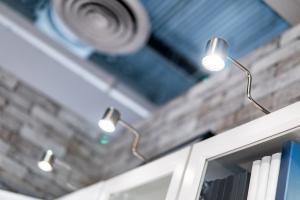Smart Lighting Systems: Enhancing Home Atmosphere Through Seamless Control
Smart lighting allows full control over brightness, color, and timing. It supports wellness, security, and energy efficiency—all from one central system”
SLIDELL, LA, UNITED STATES, June 13, 2025 /EINPresswire.com/ -- Smart lighting systems are quickly becoming a standard feature in modern residential construction. As technology continues to shape how people live and interact with their homes, lighting is no longer just a fixture—it’s an experience. From adjusting the color temperature of a room to scheduling lighting scenes for daily routines, homeowners are now able to control their environment with a simple tap on a smartphone or a voice command.— Elwin Ordoyne
This shift from traditional light switches to smart lighting systems represents more than convenience. It marks a fundamental change in how lighting interacts with lifestyle, energy use, and home design. Lights can now be programmed to simulate natural sunlight in the morning, dim automatically at night, or respond to occupancy and movement. The result is a home that responds dynamically to its occupants and enhances both comfort and function.
“Lighting isn’t just about illumination anymore,” said Elwin Ordoyne, Vice President of E.C.O. Builders Inc. in Slidell, Louisiana. “It’s become a central part of the home’s atmosphere. Smart lighting allows full control over brightness, color, and timing. It supports wellness, security, and energy efficiency—all from one central system.”
The installation of smart lighting has grown steadily in both new construction and renovation projects across Louisiana. Builders are increasingly incorporating lighting automation as part of a home’s core infrastructure, wiring for future upgrades and leaving room for integration with voice assistants, mobile apps, and even solar power systems.
A smart lighting system typically includes features such as:
Remote Control: Lights can be turned on or off from anywhere using a smartphone or tablet.
Dimming and Color Temperature Adjustment: Users can shift a room’s mood from warm and cozy to bright and focused, depending on the time of day or activity.
Scheduling: Lights can be programmed to follow routines, turning on in the morning, dimming in the evening, or switching off automatically when a room is unoccupied.
Motion Sensors: Lights respond to movement, enhancing security and eliminating wasted electricity.
Scene Setting: A single tap can activate predefined settings—such as “Movie Night,” “Dinner,” or “Wake Up”—that adjust multiple lights at once.
These systems are often integrated with whole-home automation platforms, working alongside climate control, security systems, and entertainment centers to create a cohesive smart environment. Whether managing lighting from a wall-mounted keypad, a mobile app, or a voice assistant, homeowners benefit from both functionality and ambiance.
According to industry trends, homes with integrated lighting systems are seeing increased demand, especially in suburban and semi-rural developments like those throughout St. Tammany Parish and surrounding regions. Builders and developers in Slidell, Mandeville, Covington, and beyond are partnering with technology providers to install scalable lighting systems that can grow with the homeowner’s needs.
Installation practices have also evolved. Electricians and builders now pre-wire homes with low-voltage control lines and install smart-ready junction boxes, even when the buyer hasn’t yet committed to the technology. This allows future retrofitting without the need for costly rewiring. Builders like E.C.O. Builders Inc. are designing homes that are prepared for both current and future smart features, ensuring that lighting systems can evolve as technology changes.
For energy-conscious consumers, smart lighting offers added benefits. Automated schedules and dimming capabilities can significantly reduce electricity usage. Some systems even provide usage reports and integration with solar energy systems, offering a clear view of savings and environmental impact.
In addition to residential benefits, smart lighting is gaining ground in commercial and public spaces. Restaurants, medical clinics, offices, and event spaces are using programmable lighting to align with branding, improve customer experience, and increase efficiency.
Despite the growing popularity, the key to a successful smart lighting system remains simplicity and reliability. Systems must be intuitive, responsive, and durable enough to meet daily demands. Builders and integrators play a crucial role in selecting the right platforms and ensuring seamless installation.
“Smart lighting is no longer a futuristic concept,” Ordoyne added. “It’s happening now in homes across South Louisiana. The ability to control lighting with precision adds real value to a home—functionally, visually, and technically.”
As the demand for connected living continues to grow, lighting stands at the center of smart home integration. It’s one of the first systems new homeowners experience, and one of the most visible. As construction practices evolve, smart lighting is expected to become a standard offering in new homes, shaping how living spaces are designed and enjoyed.
Morgan Thomas
Rhino Digital, LLC
+1 504-875-5036
email us here
Visit us on social media:
Facebook
Legal Disclaimer:
EIN Presswire provides this news content "as is" without warranty of any kind. We do not accept any responsibility or liability for the accuracy, content, images, videos, licenses, completeness, legality, or reliability of the information contained in this article. If you have any complaints or copyright issues related to this article, kindly contact the author above.


